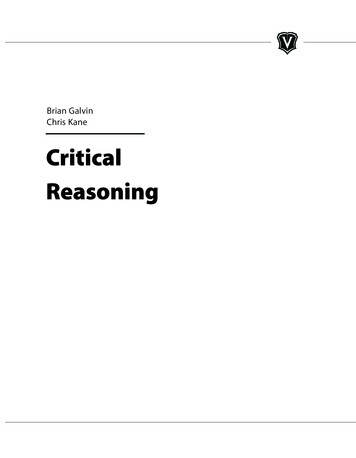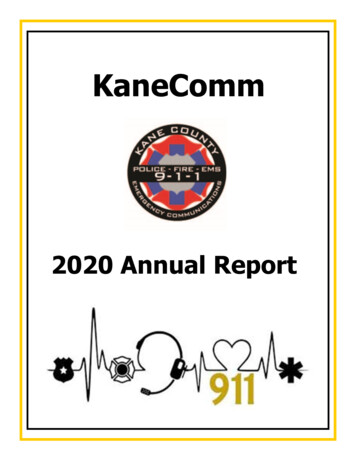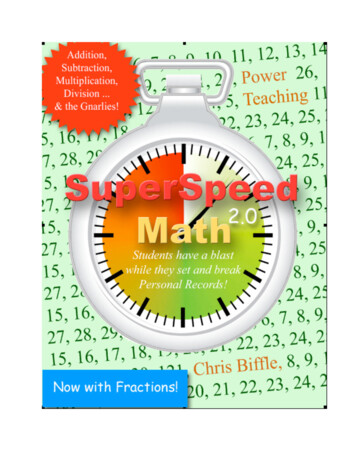
Transcription
Brian GalvinChris KaneFoundationsof GMAT Logic
AuthorsBrian GalvinChris KaneCo-foundersMarkus MobergChad TroutwineContributing WritersDavid NewlandAshley Newman-OwensContributing EditorJodi BrandonCover DesignNick MasonInterior DesignTom AhnDennis AndersonALL RIGHTS RESERVED. Printed in the U.S.A.Third Edition, Copyright 2017 by Veritas Prep, LLC.GMAT is a registered trademark of the Graduate ManagementAdmission Council, which is not affiliated with this book.No part of this publication may be reproduced, stored ina retrieval system, or transmitted in any form or by anymeans, electronic, mechanical, photocopying, recording, orotherwise without the prior written permission of VeritasPrep, LLC.All the materials within are the exclusive property of VeritasPrep, LLC. 2017.Print Batch 2017.1
This book is dedicated to Veritas Prep’s instructors, whose enthusiasm and experiencehave contributed mightily to our educational philosophy and our students’ success.It is also dedicated to the teachers who inspired Veritas Prep’s instructors. The lessonthat follows was only made possible by a lifelong love of learning and of undertakingeducational challenges; we have teachers around the world to thank for that.Finally and most importantly, this book is dedicated to our thousands of students, whohave taught us more about teaching and learning than they will ever know. And to you,the reader, thank you for adding yourself to that group.Personal DedicationsVeritas Prep is a community of educators, students, and support staff, and these bookswould not be possible without our cast of thousands. We thank you all, but would liketo specifically acknowledge the following people for their inspiration:Clay Christensen (Harvard Business School), Tom Cotner (Plymouth-Salem HighSchool), David Cromwell (Yale School of Management), Lenore Goshorn(Allen Elementary School), Henry Grubb (Fort Osage High School), Dana Jinaru(Beat the GMAT), Patricia Kenney (University of Michigan), Steven Levitt(University of Chicago), Walter Lewin (Massachusetts Institute of Technology),Lawrence Rudner (Graduate Management Admission Council), Jeff Stanzler(University of Michigan), and Robert Weber (Kellogg School of Management).
TABLE OF CONTENTSINTRODUCTION TO THE VERITAS PREP COURSE . . . . . . . . . . . . . . . . . . . . . . . . . . . . 7Foundations of GMAT Logic. . . . . . . . . . . . . . . . . . . . . . . . . . . . . . . . . . . . . . . . . . . . . . . . . . . . 7SECTION 1: GMAT OVERVIEW . . . . . . . . . . . . . . . . . . . . . . . . . . . . . . . . . . . . . . . . . . 9Format of the GMAT .9Content on the GMAT .9Understanding Computer-Adaptive Tests (CATs) .11What Is the GMAT Testing? .15SECTION 2: THE VERITAS PREP METHODOLOGY. . . . . . . . . . . . . . . . . . . . . . . . 17The Veritas Prep Pyramid .17Think Like the Testmaker .19Recurring Themes in the Veritas Prep Pyramid .21How Each Book Is Structured .24SECTION 3: GMAT QUESTION TYPES AND STRATEGIES . . . . . . . . . . . . . . . . . 27Problem Solving.28Data Sufficiency .29Sentence Correction .33Critical Reasoning . 34Reading Comprehension .35Detailed Solutions to Sample Questions .37SECTION 4: GMAT LOGIC . . . . . . . . . . . . . . . . . . . . . . . . . . . . . . . . . . . . . . . . . . . . . . 39What Is an Argument? .39Conclusions Are King .41Deconstructing Arguments .43Precision in Language . 44Logical Opposites . 46
TABLE OF CONTENTSSECTION 5: APPLYING LOGICAL PRINCIPLES TO GMAT QUESTIONS . . . . . 47Critical Reasoning: Strengthen Questions .47Critical Reasoning: Inference Questions .51Data Sufficiency Questions .55Problem Solving Questions .59SECTION 6: GETTING THE MOST OUT OF YOUR COURSE . . . . . . . . . . . . . . . . 61SECTION 7: HOMEWORK: GETTING THE MOST OUT OF THIS LESSON . . . . 63ANSWER KEY. . . . . . . . . . . . . . . . . . . . . . . . . . . . . . . . . . . . . . . . . . . . . . . . . . . . . . . . . . . . . 65
INTRODUCTIONINTRODUCTION TO THEVERITAS PREP COURSEThis lesson marks the initial lesson in the 12-lesson Veritas Prep GMAT Course. In thelesson that follows, and the 11 that follow it, you will learn how to approach the GMATfrom both a content standpoint and a strategic standpoint. These lessons have beendeveloped using one of the hallmark Veritas Prep strategies: “Learning by Doing.”After 10 years of teaching students around the world, our top instructors pooled theirknowledge to create this unparalleled collection of GMAT strategies and targetedcontent coverage. In these lessons you will learn by doing challenging problems; youwill master the core GMAT content that is critical to success; and you will begin to “ThinkLike the Testmaker,” understanding how the authors of the GMAT take these contentareas and question types and challenge even the most capable pre-MBA students.Foundations of GMAT LogicThis lesson will introduce the GMAT format and its question types, and then proceedto a crucial first step in your mission to “Think Like the Testmaker”: You will need tounderstand logic and the way that it relates to GMAT questions. You will learn thecommon fallacies that lead to tempting, incorrect answers; you will see how correctanswers are built; and you will see how to arrive at those answers by logicallyleveraging information. By the end of this lesson, you will have developed a thoughtprocess through which you can efficiently and successfully navigate each type of GMATproblem.The authors of the GMAT are careful to use the word “reasoning” when they refer toany section of the exam (e.g., Integrated Reasoning, Quantitative Reasoning, VerbalReasoning). The GMAT is a reasoning test more than it is a content test. As such, it isonly fitting that you begin your study with this coverage of the foundations of GMATlogic and reasoning.7
8
GMAT OVERVIEWFormat of the GMATGMAT OVERVIEWFormat of the GMATSectionsQuestionsAllotted TimeAnalytical Writing Assessment130 minutesIntegrated Reasoning1230 minutesQuantitativeProblem Solving/Data Sufficiency minutesVerbal Sentence Correction/Critical Reasoning/Reading Comprehension minutesTotal Time: Approximately 3 hours, minutes (including two 8-minute breaks)Section SelectYou can choose the order in which sections appear. Your options are:1)2)3)Analytical Writing, Integrated Reasoning, Break, Quantitative, Break, VerbalQuantitative, Break, Verbal, Break, Integrated Reasoning, Analytical WritingVerbal, Break, Quantitative, Break, Integrated Reasoning, Analytical WritingYou will be prompted to select your section order at the beginning of your test; if you do notmake a selection within 2 minutes of the prompt, your test will begin with Option 1's deliveryorder (Analytical Writing first).Content on the GMATAnalytical Writing Assessment The Analytical Writing Assessment (AWA) providesschools with a writing sample with which to gauge your communication ability.*O UIF UI MFTTPO PG UIJT DPVSTF ZPV XJMM MFBSO TUSBUFHJFT UP NBTUFS UIF "8" FGGJDJFOUMZ QPTUJOH B IJHI TDPSF BOE QSPWJEJOH B TUSPOH XSJUJOH TBNQMF XIJMF DPOTFSWJOH NFOUBMTUBNJOB 9
Integrated Reasoning The Integrated Reasoning (IR) section features 12 problemsin 30 minutes, with problems taking four forms: Graphics Interpretation, TableAnalysis, Two-Part Reasoning, and Multi-Source Reasoning. True to its name, theIntegrated Reasoning section assesses a set of skills that integrates quantitative abilitywith verbal and logical reasoning. Your study of the other sections of the GMATwill aid you directly with Integrated Reasoning problems, and lesson 12 of thiscourse will thoroughly cover the IR section and specific strategies to attack it.Quantitative Reasoning The Quantitative Reasoning section of the GMATconsists of 31 questions designed to assess your skill with arithmetic,elementary algebra, and basic geometry. The section features two differenttypes of multiple-choice problems: Problem Solving and Data Sufficiency. ProblemSolving questions test your mathematical skills through a familiar construct; you areasked a question, and the five choices are each potential solutions. Data Sufficiencyquestions focus even more on logic, with a set of answer choices that assesses yourability to determine which pieces of information are relative for quantitative analysis.In lessons 2, 4, and 6 you will review the fundamental topics behind arithmetic, algebra,and geometry, and learn to break them down to the level upon which difficultGMAT questions are based. In lesson 8 you will learn to master the “gamesmanship”behind Data Sufficiency by truly understanding the problem format from theperspective of the testmaker. In lesson 10 you will cover the advancedquantitative topics of probability, statistics, and combinatorics. And in lesson 11,you will learn problem-solving strategies and prepare for advanced word problems.Verbal Reasoning The Verbal Reasoning section of the GMAT consists of 36problems collectively designed to measure your ability to read critically, evaluatearguments, and recognize formal written English. The section contains threedifferent types of multiple-choice problems: Reading Comprehension, CriticalReasoning, and Sentence Correction.Lesson 3 will cover important strategies for Critical Reasoning. Lesson 5 will teach youto strategically tackle Sentence Correction. Lesson 7 will provide you with techniquesfor Reading Comprehension. Lesson 9 will take you inside the GMAT authors’playbook, showing you how testmakers make problems difficult by playing onyour mental tendencies. Lesson 12 will cover the AWA and IR sections, as well as finaltest-taking and study strategies to send you on your way to the test center withconfidence.10
GMAT OVERVIEWUnderstanding Computer-Adaptive Tests (CATs)Understanding Computer-Adaptive Tests (CATs)Since 1997, the Graduate Management Admissions Council (GMAC) has administeredthe GMAT as a computer-adaptive test (CAT). This means that you will not have tosqueeze into a crowded auditorium or cafeteria with hundreds of other test-takers atone appointed time as you must for the SAT or LSAT. Instead you will take the GMATat a computer terminal in a test center and have the ability to schedule your GMATappointment at a time convenient for you.The most notable impact that the CAT format will have for your strategy resides in theway that it is scored. When you take a CAT, the result of each question you answer willdictate the difficulty level of the next question, so that the computer can present youwith problems that narrow in on your own ability level. Computer-adaptive tests havea very different feel than paper tests for a variety of reasons: You cannot return to previously answered questions to check your work. Pacing is extremely important, as you cannot save difficult questions forlater. When you are performing well, almost all of the questions you receivewill be very difficult.How does this affect your strategy? There are a few important things to consider:1.Stubbornness is particularly punished on computer-adaptive tests.Because you will see so many hard questions when you are performingwell, you cannot get bogged down on any one question. If you arecompletely stumped after 90 seconds, it is a good idea to logically guesson a question. Learning when to dig in your heels and spend extra timeon a question and when to give up is a fundamentally important decisionon computer-adaptive tests.2. Pacing is not linear. While the average time per question is approximatelytwo minutes, there are some questions you will be able to answer in 30seconds and there are others that will require three minutes. If you aregoing to spend more than three minutes on a problem, be fairly certainthat you are going to get an answer. The worst thing that you can do onthis test is spend four minutes on a question and then still guess.11
3. Your floor is more important than your ceiling. Many students chasewhat they consider to be high-difficulty questi
of GMAT Logic Job: PGSTL00290(SP).job Page: 1 Date: 02/05/2014 Job: Untitled-1.job Page: 1 Date: 09/10/2014Job: Untitled-1.job Page: 1 Date: 09/11/2014. Authors Co-founders Contributing Writers Contributing Editor Cover Design Interior Design Brian Galvin Chris Kane Markus Moberg Chad Troutwine David Newland Ashley Newman-Owens Jodi Brandon Nick Mason Tom Ahn Dennis











